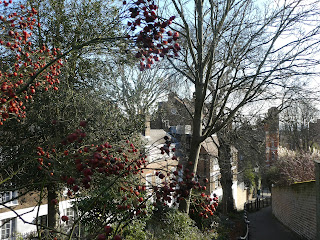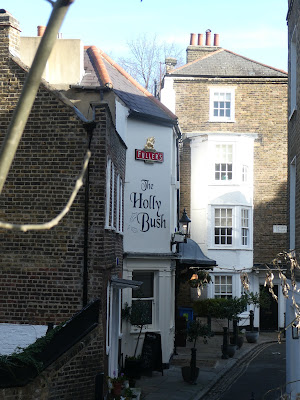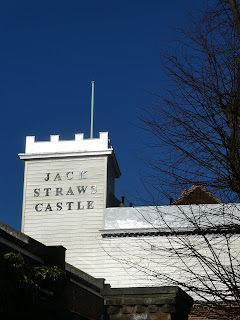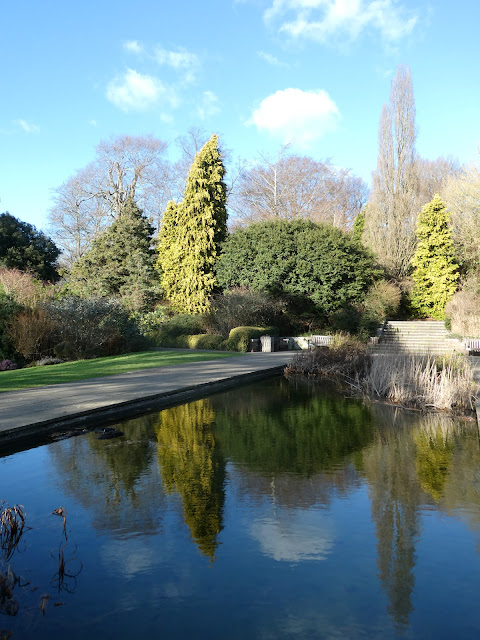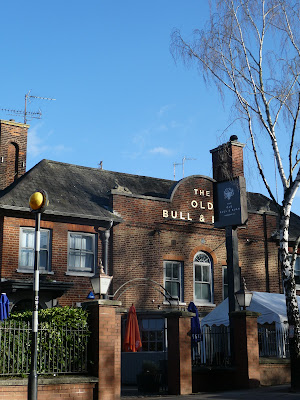A lovely Monday morning, so I thought of Hampstead for a walk. I would have started at Hampstead Tube station, but it was closed so I hopped off at Belsize Park and walked up to Hampstead, passing Hampstead Green, and its impressive church, St Stephens
So really the start of this walk in Hampstead terms was walking down Church Row, appropriate as one of the oldest and finest streets in Hampstead, and indeed one of the best Georgian streets in London, built in the early 1700s.
On it is the church of St John at Hampstead, built in 1745, but like many such churches built over many much older churches.
It also benefits from having a very nice and extensive graveyard
Constable's family tomb is here.
The interior of the church is lovely too - so light and airy.
And the graveyard has a 19th century extension, which is, like its predecessor, already full and taking no new burials.
Near St Johns is the much smaller Roman Catholic church of St Mary's, sat unobtrusively in a terrace. I would have gone in but there was service, although my presence would have significantly increased the size of the congregation, as well as lowered the average age.
Almost next door is the former Hampstead Watch House, effectively the original Hampstead police station.
For a short while this was the house of Robert Louis Stevenson, who like many came to Hampstead's clean airs as a cure for his consumption. He later moved to Samoa, but still died at the early age of 44.
The excellent Holly Bush pub, a very good gastropub. The building apparently dates back to the 1640s but was originally merely the stables to a grand house behind it.
The house of George Romney, the successful portrait artist.
Fenton House, a National Trust property, currently closed for the winter. Impressive gates!
The Du Maurier family home.
This is the Admiral's House, once owned by an eccentric sea captain who had the roof constructed like the deck of a ship, off which he would fire canons on special occasions. (And you get annoyed at the neighbours' fireworks....). John Constable lived nearby and painted the house three times.
Beyond the Admiral's House is Grove Lodge - in the distance you can see the blue plaque on it for John Galsworthy, author of the Forsyte Saga
Nearby is Judges Walk, notable only for the name, which apparently derives from the great plague when the judges decamped to the healthier airs of Hampstead, but had to make do with tents as emergency accommodation along this walk.
This is the Walk - nothing to write home about.
Although good views
Whitestone Pond, originally a spot for horses to drink...
But now just a couple of Egyptian geese imbibing.
Jack Straws Castle, until relatively recently a famous pub, now flats. Once frequented by Dickens, Thackeray and Wilkie Collins.
But the highlight if my walk was the Pergola and Hill Garden, a little known but really beautiful garden built by soap magnate Lord Leverhulme in the early 1900s. A gorgeous place to wander around on a glorious (if distinctly chilly) weekday, with few people about.
While the Pergola is a public park, Lord Leverhulme's House, now named Inverforth House, is privately owned. You can catch glimpses of it from the park. It looks massive.
Down from the pergola the Hill Garden is lovely too.
The Old Bull & Bush pub, immortalized in the music hall song. Apparently a favoured haunt of cockneys up from the East End to enjoy the better atmosphere of Hampstead.
And a blue plaque (on the charmingly titled Wildwood Terrace from the days the woods would seem wild) for Michael Ventris, of interest to those of us of a classical bent as the man who deciphered the Greek Linear B script. Another man who died ridiculously early.
This used to form part of Wyldes Farm, where William Blake and Charles Dickens both once stayed.























